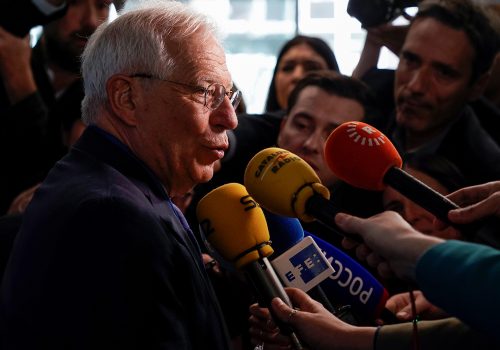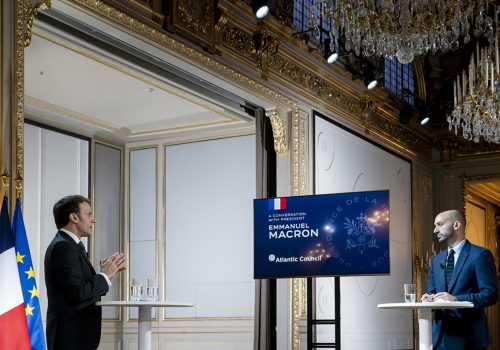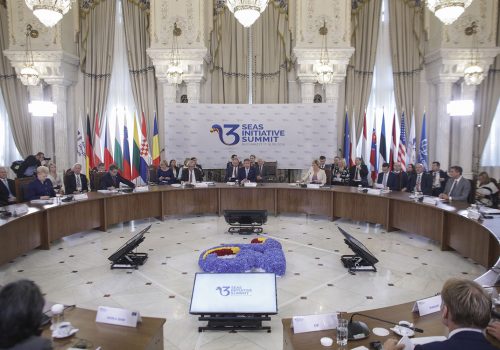A three-step plan for reviving the transatlantic alliance
Like all old friends, the United States and Europe have had their ups and downs. They’ve experienced periods of distance and even tension. But trust—grounded in common values, cultural familiarity, and a legacy of shared triumphs—has kept the relationship intact and generally enabled the two sides to pick up right where they left off.
Donald Trump’s presidency changed all that, straining this trust to near-breaking point. Past episodes of transatlantic divergence, from the Suez Crisis to the Iraq War, centered on intense policy disagreements. But Trump injected doubt into the relationship itself, as he pilloried European leaders and cozied up to avowed enemies of the European project, undermined the European Union (EU) by supporting Brexit, and threatened to pull the United States out of NATO. Such behavior is not easily forgotten—especially as Trumpism remains a potent political force in the United States.
It is hardly surprising, then, that in December the European Union pushed through a new investment treaty with China despite protestations by members of the then-incoming Biden administration. A new US president—even one with as ironclad a record on transatlantic relations as Joe Biden possesses—is not enough for the EU to alter its strategic calculus and give Washington the benefit of the doubt. The EU-China treaty reveals just how much work the Biden administration needs to do to earn back the transatlantic trust that was relinquished during the Trump years.
Biden has already taken positive steps to rebuild this trust—prioritizing introductory phone calls with European leaders, highlighting the importance of the transatlantic relationship at the Munich Security Conference, and most importantly selecting committed transatlanticists, such as Secretary of State Antony Blinken, for key foreign-policy posts.
European leaders, likewise, are racing to embrace the new US president and thinking through concrete ways to improve transatlantic ties. In the months since Biden’s election, the European Commission has drafted a white paper calling upon leaders to seize a “once-in-a-generation” opportunity to forge a new US-EU alliance and proposed establishing a Transatlantic Trade and Technology Council. NATO is reviewing the need for a new strategic concept, which would redefine the alliance’s priorities and spell out how it can confront the current security landscape. NATO has also recommended creating both a new mechanism to coordinate China policy and a Center of Excellence for Democratic Resilience to protect democratic institutions within allied countries.
Reviving the transatlantic partnership, however, will require more than the traditional close diplomacy, warm rhetoric, and lofty white papers. It will demand bold action that proves the United States and Europe can still accomplish major feats together. A unified vision is a good start, but ultimately insufficient: America and Europe must set out to do big things and then execute on them, creating a new legacy of joint triumphs that their citizens can rally around and upon which future generations can build. It is only with such foundational touchstones, which galvanize a fresh political consensus in favor of the transatlantic bond, that real trust and all the benefits that it brings can be restored.
Creating these new touchstones will require investments of time, resources, and political capital. There is a significant list of issues on which deep transatlantic cooperation could make a major difference. Attempting to boil the ocean, however, would be a recipe for failure. US and European leaders must prioritize. The key is to select a small number of urgent and tangible projects with good odds of success. Three projects—ending the COVID-19 pandemic, reinvigorating transatlantic security, and reconciling US and European policies on technology—should rise to the top of the agenda.
Step 1: Defeat COVID-19
The best place to start is also the most obvious: working together to end the pandemic. Both the United States and Europe have struggled mightily with COVID-19, suffering some of the highest infection and death rates in the world. Until the United States and Europe tame the pandemic, their economies will languish and they will find it impossible to pursue ambitious global agendas. Moreover, the longer the West flounders in its response to the virus, the more its international standing will diminish.
With the successful development of at least three viable vaccines by US pharmaceutical companies Johnson & Johnson, Moderna, and Pfizer—the latter in partnership with the German biotechnology company BioNTech in a historic accomplishment of transatlantic scientific cooperation—the United States and Europe have a chance to flip the script. They should agree to a joint plan for ensuring that these vaccines are manufactured and distributed as rapidly and equitably as possible across the globe. Such a plan could guard against supply-chain disruptions and wasteful hoarding, while focusing on coordinated ways to deliver doses to both domestic populations and developing countries. Biden’s pledge of four billion dollars to COVAX is a good start. But leading efforts to vaccinate the globe will require hands-on coordination, not just cash.
By taking a leadership role in vaccine manufacturing and distribution, the United States and Europe could recover some of the soft power they have relinquished through their shambolic handling of the pandemic thus far. The Trump administration’s pointed refusal to participate in international efforts to cooperate on vaccine development and delivery has hampered US diplomacy abroad, fueling a narrative that Washington is unwilling and possibly incapable of addressing the most serious crisis since World War II.
For Biden to follow through on his aim of restoring democracy’s global standing, the United States and its democratic allies in Europe must restore the world’s faith in the competence of democratic governance. By working together to end the pandemic both at home and abroad, they can do just that.
Step 2: Reinvigorate transatlantic security
Nowhere has the damage to transatlantic trust been more acute than on defense and security issues. Trump’s animosity toward NATO fundamentally undermined the alliance—shaking internal confidence that the United States would uphold its Article 5 commitments and weakening deterrence against adversaries like Russia. Although Trump continued and accelerated previous US efforts to bolster allied defense spending, his single-minded focus on making allies “pay their fair share” wounded the alliance and oversimplified the challenge of enhancing allied defense.
Biden will invariably seek to repair the damage that his predecessor inflicted on NATO. The US president should continue making calls to every NATO ally to reinforce the US commitment to Article 5, propose concrete ways to strengthen the alliance during a virtual meeting of NATO leaders this spring, and offer to host a NATO summit in the United States during his first year in office to finalize a new strategic concept for the alliance. These steps, however, should mark just the beginning of a broader agenda to rethink transatlantic security.
Whereas Trump repeatedly battered NATO allies for failing to meet the defense-spending goal of 2 percent of gross domestic product, Biden’s priority should be on preparing the alliance to confront current and future security threats. Designing a more constructive approach to burden-sharing could help address the need for greater defense contributions while acknowledging that allies need time to meet political commitments in a challenging economic environment. Allies could be judged on additional barometers such as their ability to direct 20 percent of defense spending toward investments in new capabilities, support for hitting mutually agreed targets for NATO capabilities, tangible assistance for the alliance’s exercises and operations, commitments to NATO’s readiness and mobility initiatives, and investments in civil-military resilience. The best way to pressure allies over failed commitments is to do so diplomatically and privately, rather than publicizing American complaints.
No one benefited more from Trump’s attacks on the alliance and Europe’s resulting doubt in US leadership than Russian President Vladimir Putin, who has sought for years to weaken NATO and sever American ties to the continent. Biden, by contrast, should emphasize that there can be no more “resets” with Russia while it continues to occupy its neighbors’ territory, interfere in elections abroad, conduct massive cyberattacks against NATO allies, assassinate political opponents, and forcefully suppress peaceful protestors at home. The administration’s close coordination with the EU on the imposition of new Russia sanctions this month marks an important first step.
NATO, in turn, should reinvigorate its Russia strategy and focus on enhancing deterrence measures against potential Russian attacks on NATO members and along the alliance’s periphery. The transatlantic partners should create an EU-NATO Coordinating Committee on Russia, which could serve as a standing mechanism for aligning policies on sanctions, anti-money laundering, counter-disinformation, and cybersecurity. As Russia seeks to erode faith in democracies from the inside out, it is essential for transatlantic partners to focus on security threats beyond the military domain. Allies will also need to enhance existing programs to build defense capacity in countries such as Ukraine and Georgia, while leaving open the possibility of bringing these countries into NATO in the future.
Pursuing realistic opportunities for cooperation and dialogue with Russia, however, should not be discounted. Building on its willingness to extend the New START nuclear-arms treaty with Moscow, the Biden administration should offer to engage Russia on broader strategic stability talks and on expanding military-to-military talks to avoid escalations with NATO military forces.
The Biden administration should also avoid the endless theoretical debates that have plagued transatlantic security discussions for years. Rhetorical questions over whether European countries should increase their defense budgets, whether the EU should have a more integrated defense apparatus, or whether NATO should focus more on threats outside its traditional area of focus such as China are now moot. The answer to all these questions is: Yes. Now that its allies have mostly accepted these responsibilities, Washington should accept a stronger EU that is more capable of sharing leadership with the United States. A robust EU defense apparatus, if it ever came to fruition, would strengthen transatlantic security, not weaken it. A stronger EU would be better positioned to stand up to Russia and China, which also serves US interests. And the prospect of a unified EU defense capability may well prove more politically palatable in Europe than “burden-sharing.”
Related reading
Step 3: Forge a united front on technology
For the last seventy-five years, the transatlantic bond has been supported by two pillars: security and economics. The overarching objectives of the relationship have been to defend each other against external threats and to buttress a global economy characterized by the free flow of goods and capital. It is time to add a third pillar: technology.
The United States and Europe have defaulted to treating information technology as just another industry—one best left to the free market to drive forward, with regulation primarily the province of individual governments. The problem with this approach is that technology is not just another industry. It has become the critical infrastructure of human life in the twenty-first century, facilitating our communications, powering our workplaces, storing our personal information, and enabling us to buy food, medicine, and other necessities at the press of a button. And this is just the beginning: In the coming decades, technology will likely drive our cars, serve as our identification cards, and replace our wallets.
Ensuring the safety, security, and accessibility of this infrastructure should become a paramount priority of the transatlantic relationship. The European Commission’s proposal to create a Transatlantic Trade and Technology Council is a good place to start. But the true test of success will be whether the United States and Europe are prepared to take significant actions to forge a united front on emerging technologies.
The first category of actions should center on protecting US and European societies from foreign governments that could use technology for malicious ends. After World War II, the United States and a handful of European countries established the Coordinating Committee for Multilateral Export Controls (COCOM), which was tasked with preventing sensitive military technologies from falling into the hands of the Soviet Union. Creating a similar transatlantic body focused on frontier technologies, regardless of whether they have direct military applications, would allow US and European officials to align their export-control regimes—and thus institute clear guardrails designed to avoid the game of whack-a-mole that Washington has had to play with regard to the Chinese technology company Huawei.
The United States and Europe would benefit from a similar standing body focused on investment screening. Over the last several years, the United States has beefed up its own investment-screening mechanism, the Committee on Foreign Investment in the United States (CFIUS), by making filings mandatory for certain types of investments and imposing more stringent review of transactions involving critical technologies. In 2020, the European Union rolled out its own investment-screening framework, bringing a degree of EU oversight to a policy area that has long been left to individual member states. While a step in the right direction, the EU framework remains fledgling. And up to this point, there has been minimal transatlantic cooperation on investment screening. Instead of building these regimes in parallel, the United States and Europe should seek to harmonize them from the outset.
The second category of actions should focus on proactive investment. In Washington and Brussels, there is much interest in setting global standards for new technologies. But standards are as much a consequence of scale and adoption as they are of regulation. For too long, the United States and Europe have sat on the sidelines as China has aggressively funded infrastructure development around the world through its Belt and Road Initiative (BRI). These investments have created de-facto standards in various regions that cannot simply be overturned by regulation.
To set standards for new technologies, the United States and Europe must put money behind their efforts—financing 5G networks and other digital infrastructure in countries around the world. Platforms to provide this financing, such as the Blue Dot Network, the EU-Asia Connectivity Strategy, and the Three Seas Initiative, have emerged in recent years. But none has garnered the necessary political support or financial backing to have a major impact. Under the umbrella of the D-10 group of democracies, an expanded version of the Group of Seven (G7) that will meet at the leader level for the first time this summer, the United States, the European Union, and other leading democracies should back these platforms with a common vision and pool of funds. Such unity of effort will be critical for the transatlantic partners to launch a compelling alternative to BRI and set standards for new technologies around the globe.
New feats for a new era
Defeating COVID-19, reinvigorating transatlantic security, and forging a united front on technology constitute an ambitious agenda. But ambition will be required to revive the transatlantic relationship and tackle the monumental challenges that the United States and Europe face. Moreover, while each of these agenda items will take significant time and resources to accomplish, they are all eminently achievable if the transatlantic partners approach them with shared vision and the requisite domestic political support.
Fulfilling this agenda will not only do tremendous good in and of itself but also provide the United States and Europe with the confidence and political capital to take on further challenges. At the top of that list is climate change. Biden has rejoined the Paris climate accord and appointed a high-powered climate team. But for the United States to regain credibility in international climate negotiations, the Biden administration will need to earn it through sustained, aggressive action to curb US emissions and promote green development.
The United States and the European Union should begin consulting soon on more ambitious measures to tackle climate change like a coordinated border tax on carbon. Such a tax is already a centerpiece of the European Green Deal, and it would be most effective if it were aligned with similar policies in the United States and other major powers. Regardless of whether the Biden administration can move such a tax through Congress, it can commit to making climate a central consideration across the full spectrum of transatlantic relations and push US policy as far as the country’s political system will allow.
The transatlantic relationship was built on a foundation of great feats: victory in World War II, the reconstruction of Europe, and the creation of a new international order. But the world is now entering a new era, and the United States and Europe must jointly meet the new challenges they confront. Nothing short of setting out bold endeavors—and bringing them to fruition—will be required for the transatlantic relationship to once again serve as the bedrock of global peace and prosperity.
Edward Fishman is a nonresident senior fellow at the Atlantic Council. He advised Secretary of State John Kerry on Europe and Eurasia as a member of the Policy Planning Staff and served on the negotiating team that designed US-EU sanctions in response to Russia’s invasion of Ukraine.
Mark Simakovsky is a nonresident senior fellow at the Atlantic Council. He served as chief of staff in the Europe/NATO Office at the Pentagon, served as Russia director in the Office of the Secretary of Defense for Policy during the 2014 Russian invasion of Ukraine, and advised Secretary of Defense Robert Gates throughout Russia’s 2008 invasion of Georgia.
Further reading
Image: NATO and EU flags at the Europa Building in Brussels via Reuters


